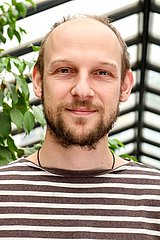


Supervisor: Gerhard Herndl
PhD student: Paul Steiner
Group: Microbial Oceanography, Department of Limnology and Bio-Oceanography
Successional changes in marine snow in the northern Adriatic: relation between the age and morphology of marine snow and N cycling
Marine snow particles are mainly generated due to aggregation of phytoplankton exudates with other organic substances. High nutrient concentrations in marine snow lead to increased abundance and activity of marine snow-associated prokaryotes. While the community composition of marine snow-associated and free-living prokaryotes is well known, seasonal dynamics within those communities are less well understood. The northern Adriatic Sea is known for the occurrence of marine snow. Particularly in late summer, large non-sinking marine snow accumulates just above the pycnocline. We hypothesized that oxygen-deficient microzones develop within aged marine snow due to heterotrophic microbial activity. Furthermore, we hypothesized that the marine snow-associated prokaryotic community is spatially structured according to oxygen concentrations. We expected to find the potential for anoxic processes, such as denitrification and dissimilatory nitrate reduction in the center of aged marine snow particles. Marine snow was collected with sterile syringes at 10 m depth by SCUBA diving over a seasonal cycle. We also collected the ambient water with Niskin bottles at the same depth as marine snow. Marine snow was present during all sampling campaigns ranging from approximately 0.2mm to 1cm diameter. Large accumulations of marine snow, as reported previously, have not been observed. Also, due to the fragile nature of marine snow, oxygen determinations and embedding of single particles in resins for fluorescence microscopy analysis was not possible. DNA based methods, such as metagenomics and qPCR on pooled marine snow particles were used instead. In the first study of the thesis we show the seasonality of demethylating marine snow-associated and free-living bacteria and link it to DMSP concentrations. We highlight the possibility of summer and winter ecotypes, adapted to high and low DMSP concentrations, respectively. We had planned to use metatranscriptomics to determine the active components and processes of the marine snow-associated and free-living community, but we were concerned about the applicability of the method due to previous reports on short mRNA half-life time. Hence, in the second study we determined the potential of mRNA to obtain insights into metabolic processes. We tested the half-life time of individual transcripts of isolated bacteria and the relation to temperature and of a metatranscriptome of an environmental seawater sample. Overall, the mRNA half-life time ranged from as short as 1 min to 45 min of the isolates and from 1 min to 400 min of families in the environmental seawater sample, indicating a high variability of mRNA stability. Furthermore, we found that the short mRNA half-life time of transcripts with functions related to cell motility and defense mechanisms is an evolutionary conserved trait. The third study of the thesis focuses on the metabolic potential of marine snow-associated and free-living prokaryotes in summer and winter based on metagenomics. Data analysis is still in progress. We found strong differences of the summer and winter marine snow-associated prokaryotic community. Functional gene analyses revealed a higher potential for dissimilatory nitrate reduction in marine snow than in the ambient water. We also include eukaryotic community composition in future analyses, performed by experts from the ICM CSIC in Barcelona. This collaboration was established during the secondment at the ICM CSIC.
Co-supervisors: Wolfgang Wanek & Christa Schleper.
Secondment: J. Gasol (CSIC Barcelona, Spain)
Please find a list of publications here.